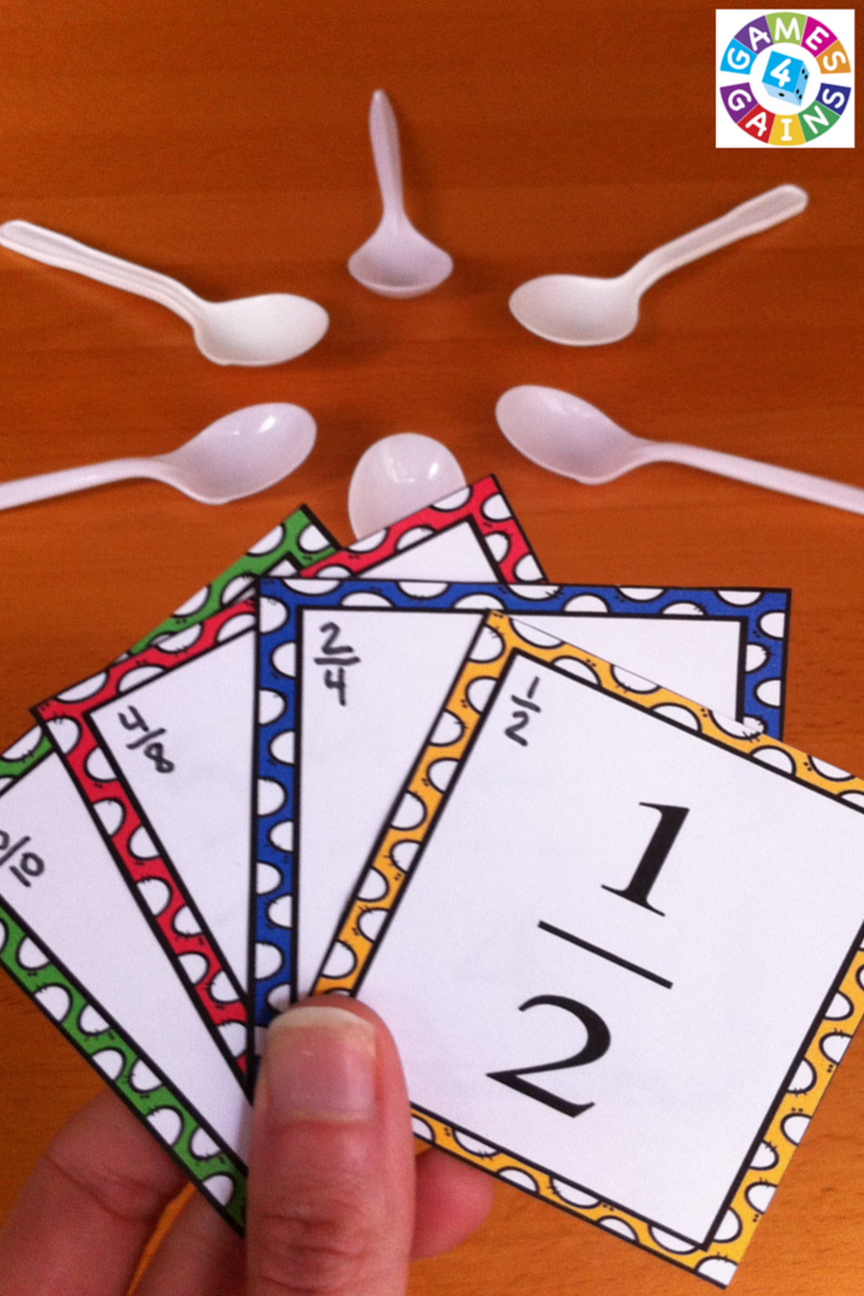RECUERDA LAS FRACCIONES EQUIVALENTES
EQUIVALENT FRACTIONS GAME OF 'SPOONS'
Posted by Brittney Field on Aug 27, 2015

This game for practicing equivalent fractions is a variation on the classic card game "Spoons." If you've ever played "Spoons" before, you know that the game is super fast-paced and lots of fun. I figured that if I could combine the fun and exciting parts of "Spoons" with some equivalent fractions practice, I'd have a center game that my students would be dying to play. And let me tell you, this one does not disappoint!
How to play Equivalent Fractions "Spoons":
Number of players: 3-6 players
Preparing the materials:
1. Print out the Equivalent Fraction cards that we've created for this game by CLICKING HERE. Cut out each of the cards.
2. Grab some plastic spoons (or any other object that can be grabbed by the players). You need one fewer than the number of players. For example, if you have 6 players, you'll need 5 spoons.
Object of the game:
To be the last player remaining in the game. Players get closer to being eliminated each time they are left without a spoon, which earns them the next letter in the word S-P-O-O-N. Once a player has earned all 5 letters in the word S-P-O-O-N, he or she is out.
Getting ready to play:
1.Arrange the spoons in a small circle in the center of the table.
2.Shuffle the equivalent fraction game cards and deal four cards face down to each player. The players may look at their own cards, but may not show their cards to anyone else.
3.Choose a dealer for the round. The remaining cards should be placed in a pile facedown beside the dealer.
Playing the game:
1.The dealer takes a card off the top of the pile so that he or she now has five cards in his or her hand. The dealer removes one of the five cards from his or her hand and passes it facedown to the player on his or her left. The dealer then continues to pick up cards from the pile and discard one card at a time to the player on his or her left.
2.The player to the left of the dealer picks up the discarded card from the dealer. Like the dealer, he or she removes one of the five cards from his or her hand and passes it facedown to the person on his or her left. He or she continues to do this as cards continue getting discarded to him or her.
3.This quick picking up and passing of cards continues around the circle. The last player in the circle always places his or her discarded card into a trash pile. These cards are now out of play for the round.
4.Once someone gets four-of-a-kind (four fraction cards that are equivalent makes four-of-a-kind) in his or her hand, he or she grabs a spoon from the center of the table. Once the player with four-of-a-kind takes a spoon, everyone else tries to immediately grab a spoon (even if they do not yet have four-of-a-kind).

5.The player left without a spoon earns a letter in the word S-P-O-O-N.
6.The round is now over and the game begins again. If any players were eliminated during the last round, a spoon must be removed so that there is always one fewer spoon on the table than players.
Did your students enjoy playing this game? We'd LOVE it if you'd share one of these images on social or leave a comment in the space below!


TALLER 2
TALLER 3
LA BARAJA DE CÁLCULO MENTAL CON PORCENTAJES
Observaciones.
“El cálculo mental junto con los algoritmos de lápiz y papel y la calculadora, constituye uno de los pilares necesarios sobre el que basar cualquier aproximación rigurosa al cálculo numérico con alumnos del primer ciclo de ESO.”
Así empieza el capítulo sobre cálculo mental del libro “Matemáticas para la ESO: primer ciclo” del Grupo Cero de Valencia (Editado por Edelvives: ISBN: 84-263-3229-3).
En este capítulo, el conocido grupo propone un juego de cartas para que los alumnos y alumnas aprendan jugando a aproximar el resultado obtenido al aplicar un porcentaje, descuento o aumento porcentual a una cantidad.
Presentamos aquí 4 de las 8 posibles barajas que propone el grupo.
Material para cada equipo:
– Una baraja de 10 cartas./- Una calculadora./- Una tabla de los resultados de todos los equipos del grupo que se coloca como mural, como la siguiente:
El juego consiste en estimar el precio de un objeto después de aplicarle un determinado aumento o descuento.
Nivel: 1º-2º de ESO. 3º de ESO como motivación y refuerzo.
Reglas del juego:
– Juego para cuatro jugadores.
– Siguiendo un turno, un jugador del equipo coge una baraja y la calculadora. Enseña una carta y mientras los otros tres jugadores de su equipo estiman el precio final, él lo calcula con la calculadora.
– El jugador que se aproxima más al resultado consigue un punto.
– Cuando se han destapado las 10 cartas de la baraja termina la ronda. El jugador que ha conducido el juego en esa ronda anota en la tabla del mural las puntuaciones de sus compañeros.
– El juego acaba cuando se han realizado cuatro rondas, cambiando claro el jugador que conduce en cada ronda, con las cuatro barajas propuestas.
– Gana el jugador que ha conseguido la máxima puntuación.
– Las cuatro rondas se pueden realizar en varios días, ocupando sólo un momento de la clase.
Descarga aquí la actividad para el profesorado:La baraja de calculo mental con porcentajes profesor
Descarga las cuatro barajas de 10 cartas, propuestas aquí:Cartas de las cuatro barajas
TALLER 4
PROYECTO ESCHOLARIUM






0 comentarios:
Publicar un comentario